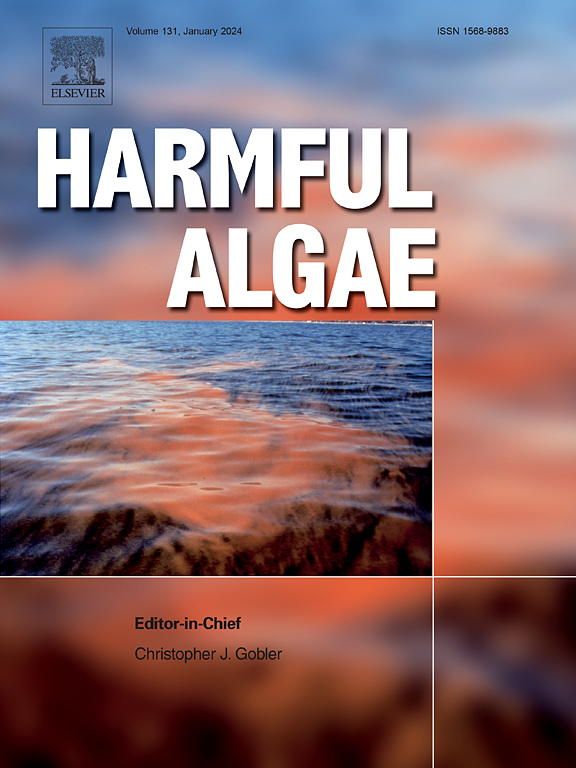Phosphorus rather than nitrogen driving biosynthesis of diarrhetic shellfish toxins in Prorocentrum caipirignum via ATP
IF 4.5
1区 生物学
Q1 MARINE & FRESHWATER BIOLOGY
引用次数: 0
Abstract
Okadaic acid and its analogues such as dinophysisitoxins-1, -2 (DTX-1, -2) are potent inhibitors of protein phosphatase and causative toxins of diarrhetic shellfish poisoning (DSP). These toxins are produced by dinoflagellate genera Dinophysis and Prorocentrum. Numerous studies have reported that the cellular content of these toxins increased under macronutrient limitation or other stress conditions in genus Prorocentrum. However, our recent study demonstrated positive linear or exponential relationships between toxin production rate (Rtox) and phosphate consumption rate in five strains of P. lima complex/P. caipirignum. To further clarify macronutrients roles in OA production, P. caipirignum SE10 selected for its extremely low DTX-1 content due to potential competitive relationship with OA, was exposed to nitrogen (N) or phosphorus (P) limitation via batch or semi-batch cultures, after which the depleted nutrients were replenished to assess OA production dynamics. The Rtox of OA peaked initially before declining under both N and P-limited treatments. Notably, Rtox increased only upon P replenishment rather than N replenishment, confirming phosphorus's critical role in OA production. In P-addition experiments, Rtox stagnated in the P-deficient condition but rose proportionally with increasing P concentration. Meanwhile, ATP and NADPH levels surged 7.5-fold and 1.5-fold, respectively, within 1 h of P-addition compared to P-deficient treatment. To probe how P affects OA production, inhibitors targeting ATP and NADPH synthesis were applied. OA production was specifically suppressed by ATP inhibitors, such as N, N-dicyclohexylcarbodiimid (DCCD), rotenone (ROT), and 2,4-dintrophenol (DNP). The highest inhibition occurred with 20 μM DCCD, reducing OA cellular content by 90 % after 48 h. Moreover, increasing ATP inhibitor concentration shift Rtox from positive to negative values. These finding demonstrated that phosphorus drives OA production primarily by modulating ATP levels, which directly regulate toxin synthesis.
磷而非氮通过ATP驱动腹泻贝类毒素在caipirignum原体内的生物合成
冈田酸及其类似物如dinophysisitoxins-1, -2 (DTX-1, -2)是蛋白磷酸酶的有效抑制剂和腹泻性贝类中毒(DSP)的致病毒素。这些毒素是由鞭毛藻属鞭毛藻和原鞭毛藻产生的。大量研究报道,在大量营养限制或其他胁迫条件下,原心属植物细胞中这些毒素的含量增加。然而,我们最近的研究表明,5株P. lima复合体/P的毒素生产速率(Rtox)和磷酸盐消耗速率之间存在正线性或指数关系。caipirignum。为了进一步阐明巨量营养素在OA生产中的作用,我们选择了与OA存在潜在竞争关系、dx -1含量极低的P. caipirignum SE10,通过批量或半批量培养,将其暴露于氮(N)或磷(P)限制条件下,然后补充耗尽的营养物质,以评估OA生产动态。在限氮限磷处理下,OA的Rtox均先达到峰值后下降。值得注意的是,Rtox只在补磷而不是补氮时增加,这证实了磷在OA生产中的关键作用。在补磷试验中,Rtox在缺磷条件下停滞不前,但随着磷浓度的增加呈比例上升。与缺磷处理相比,补磷处理1 h内ATP和NADPH水平分别上升7.5倍和1.5倍。为了探究P如何影响OA的产生,我们使用了靶向ATP和NADPH合成的抑制剂。OA的产生被ATP抑制剂特异性抑制,如N, N-双环己基碳二胺(DCCD)、鱼藤酮(ROT)和2,4-二酚(DNP)。20 μM DCCD抑制作用最强,48 h后OA细胞含量降低90%,ATP抑制剂浓度的增加使Rtox由阳性变为阴性。这些发现表明,磷主要通过调节ATP水平来驱动OA的产生,而ATP水平直接调节毒素的合成。
本文章由计算机程序翻译,如有差异,请以英文原文为准。
求助全文
约1分钟内获得全文
求助全文
来源期刊

Harmful Algae
生物-海洋与淡水生物学
CiteScore
12.50
自引率
15.20%
发文量
122
审稿时长
7.5 months
期刊介绍:
This journal provides a forum to promote knowledge of harmful microalgae and macroalgae, including cyanobacteria, as well as monitoring, management and control of these organisms.
 求助内容:
求助内容: 应助结果提醒方式:
应助结果提醒方式:


